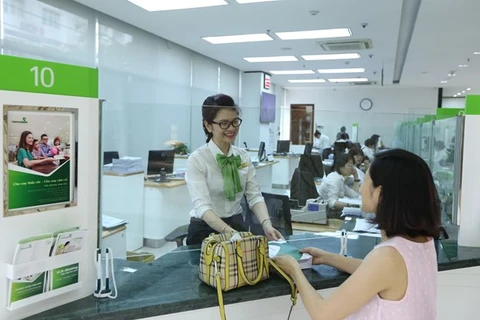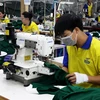Hanoi (VNA) - The financial market in 2020 will become much more unpredictable and less active than the predictions made at the end of 2019 due to impact caused by the 2019 novel coronavirus (2019-nCoV) epidemic, according to a financial analyst.
Nguyen Duc Hung Linh, Chief Economist and Director of Retail Research and Investment Advisory of Saigon Securities Inc. (SSI), said China holds a key position in the global supply chain, so the economic losses from the 2019-nCoV epidemic will make the global financial market unpredictable and less active.
According to the analyst, China is a key player in the global supply chain, so the total economic losses caused by the pandemic could be much greater than the 40-billion-USD losses caused by the global Severe Acute Respiratory Syndrome (SARS) outbreak in 2003.
The unexpected disease outbreak makes other important events, including the US-Iran political tension, the US-China trade agreement, Brexit – the UK’s decision to leave the EU - or the January meeting of the US Federal Reserve (FED), become not so important any longer, he noted.
A blow to China’s economy
In the global financial market, the first-phase trade agreement between the US and China is considered as the most expected event in January, but the appearance of the two other major events - the US-Iran conflict and the 2019-nCoV outbreak - have interfered with the optimistic atmosphere of investors.
The sentiment of investors is constantly fluctuating and shown most clearly through the fluctuation of the refuge currency – Japanese yen (JPY). The currency bottomed in mid-January while peaking at the beginning and the end of the month, the gap between the top and the bottom reached even 1.92 percent.
Besides, the prices of gold and US government bonds increased sharply, while the oil price dropped promptly.
The 2019-nCoV epidemic also dealt a blow to China’s economy, which is currently experiencing instabilities. The loosening policies of the People's Bank of China will continue to be enhanced to revive its economy.
Accordingly, the yuan of China recovered in the whole month but in the coming time, the pressure of depreciation of this currency will remain high, Linh said.
In global financial markets, most currencies have gone down against the USD in the past month, the strongest of which is the baht of Thailand.
Previously, the baht appreciated by 8 percent in 2019, marking the strongest in Asia and ranking 2nd globally after Russia. So, in the early days of the year, the Bank of Thailand (BoT) announced that it will take measures to curb the rise. However, the 2019-nCoV outbreak caused heavy damage to the tourism industry – the spearhead economic sector of Thailand, causing the baht to depreciate by 4.94 percent in January.
Besides, the two currencies with the sharp depreciation in the month were the won of the Republic of Korea and the ruble of Russia, with respective depreciation of 3.46 percent and 3.25 percent, causing trade disruptions and forcing oil prices down.
At present, the disease’s developments still impact the international financial market. Positive factors such as the US’s economic index, the loosening by central banks or the improvement of US-China relations may create certain effects but when the disease is not put under the control, the risk of volatility in the financial market will still be high, Linh stressed.
 Nguyen Duc Hung Linh, Director of Retail Research and Investment Advisory of the Saigon Securities Inc. (Photo: VietnamPlus)
Nguyen Duc Hung Linh, Director of Retail Research and Investment Advisory of the Saigon Securities Inc. (Photo: VietnamPlus)
Foreign currency supply abundant
In the domestic market, Linh said that in January, the USD/VND exchange rate moved almost around the closing level in 2019 thanks to the abundant supply of foreign currencies. In addition, the State Bank of Vietnam maintained a move to buy in foreign currencies in weeks before the Lunar New Year (Tet) festival.
However, after the holiday, under the pressure from international markets, the USD/VND exchange rate rebounded in both the commercial banking system and the free market. Therefore, the exchange rate in banks was between 23,100 - 23,270 VND per USD, an increase of 20 - 40 VND per USD. In the free market, the exchange rate was between 23,200 - 23,300 VND per USD, an increase of 30 - 120 VND per USD compared to the level at the end of 2019.
The central rate was revised up by 39 VND per USD to a new peak of 23,196 VND per USD while the buying rate offered by the State Bank remained unchanged at 23,175 VND per USD.
According to Linh, in 2020, the funneling of money through the buying of foreign currencies from the State Bank will be somehow more limited because the supply of foreign currencies is difficult to increase. Besides, the State Treasury's cash flow may be also narrowed as the disbursement of public investment in 2020 is accelerated. However, through this fiscal instrument, the amount of currency in circulation will increase, helping commercial banks increase deposit mobilisation, thereby supporting the reduction of interest rates in the direction set out.
Regarding the disease, in a meeting with 21 commercial banks on February 6, the State Bank’s representative asked commercial banks not to raise interest rates but instead take measures to support borrowers to minimise damage to the national economy amid the epidemic.
The epidemic may make it harder for deposit and lending rates to go down, but with the drastic direction of the Government, interest rates are likely to be reduced, especially in the second half of the year, if the epidemic is well controlled and the public investment disbursement shows good results, Linh said./.
























